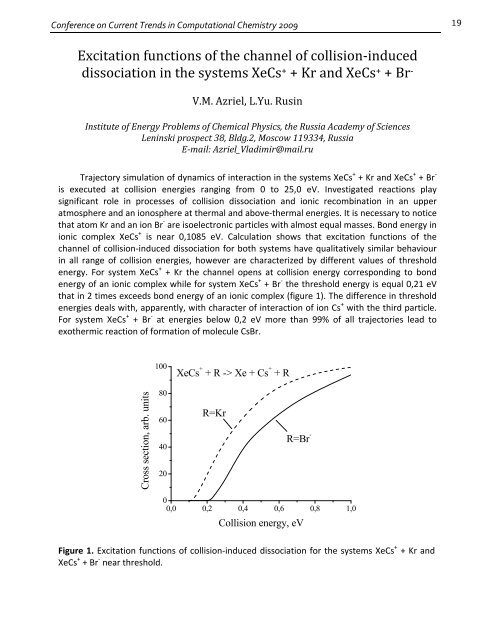Proceedings - Interdisciplinary Center for Nanotoxicity
Proceedings - Interdisciplinary Center for Nanotoxicity
Proceedings - Interdisciplinary Center for Nanotoxicity
You also want an ePaper? Increase the reach of your titles
YUMPU automatically turns print PDFs into web optimized ePapers that Google loves.
Conference on Current Trends in Computational Chemistry 2009<br />
Excitation functions of the channel of collision‐induced<br />
dissociation in the systems XeCs + + Kr and XeCs + + Br ‐<br />
V.M. Azriel, L.Yu. Rusin<br />
Institute of Energy Problems of Chemical Physics, the Russia Academy of Sciences<br />
Leninski prospect 38, Bldg.2, Moscow 119334, Russia<br />
Email: Azriel_Vladimir@mail.ru<br />
Trajectory simulation of dynamics of interaction in the systems XeCs + + Kr and XeCs + + Br ‐<br />
is executed at collision energies ranging from 0 to 25,0 eV. Investigated reactions play<br />
significant role in processes of collision dissociation and ionic recombination in an upper<br />
atmosphere and an ionosphere at thermal and above‐thermal energies. It is necessary to notice<br />
that atom Kr and an ion Br ‐ are isoelectronic particles with almost equal masses. Bond energy in<br />
ionic complex XeCs + is near 0,1085 eV. Calculation shows that excitation functions of the<br />
channel of collision‐induced dissociation <strong>for</strong> both systems have qualitatively similar behaviour<br />
in all range of collision energies, however are characterized by different values of threshold<br />
energy. For system XeCs + + Kr the channel opens at collision energy corresponding to bond<br />
energy of an ionic complex while <strong>for</strong> system XeCs + + Br ‐ the threshold energy is equal 0,21 eV<br />
that in 2 times exceeds bond energy of an ionic complex (figure 1). The difference in threshold<br />
energies deals with, apparently, with character of interaction of ion Cs + with the third particle.<br />
For system XeCs + + Br ‐ at energies below 0,2 eV more than 99% of all trajectories lead to<br />
exothermic reaction of <strong>for</strong>mation of molecule CsBr.<br />
Cross section, arb. units<br />
100<br />
80<br />
60<br />
40<br />
20<br />
XeCs + + R -> Xe + Cs + + R<br />
R=Kr<br />
R=Br -<br />
0<br />
0,0 0,2 0,4 0,6 0,8 1,0<br />
Collision energy, eV<br />
Figure 1. Excitation functions of collision‐induced dissociation <strong>for</strong> the systems XeCs + + Kr and<br />
XeCs + + Br ‐ near threshold.<br />
19



